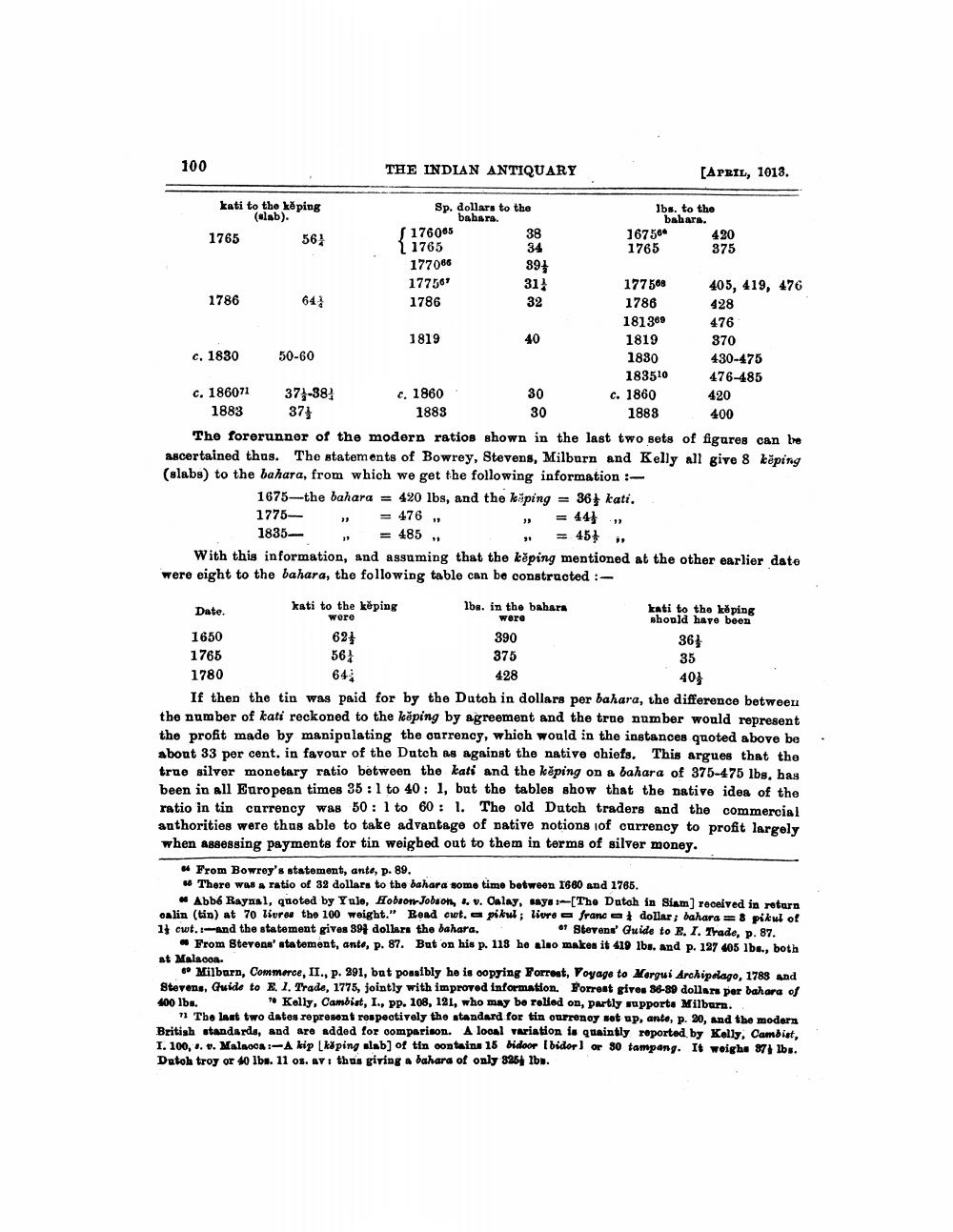________________
100
THE INDIAN ANTIQUARY
[APRIL, 1013.
38
39} 31:
kati to the keping Sp. dollars to the
lbs. to the (slab). bahsra.
bahars. 1765 56 S 176065
16758 420 1 1765
1765 375 177066 177567
177569 405, 419, 476 1786 64 1786
1786
428
181369 476 1819
1819
370 c. 1830 50-60
1830 430-475
183510 476-485 c. 186071 37-381 c. 1860
c. 1860 420 1883 374 1883
1883 400 The forerunner of the modern ratios shown in the last two sets of figures can be ascertained thus. The statements of Bowrey, Stevens, Milburn and Kelly all give 8 köping (slabs) to the bahara, from which we get the following information :
1675---the bahara = 420 lbs, and the kšping = 36 kati. 1775— = 476.
= 444 1835- = 485 ,
, = 454 i With this information, and assuming that the këping mentioned at the other earlier date were eight to the bahara, the following table can be constructed :
30
30
Date.
wore
36}
kati to the keping Iba. in the bahara
kati to the keping were
should have been 1650 621
390 1765 561 375
35 1780 64; 428
403 If then the tin was paid for by the Dutch in dollars per bahara, the difference between the number of kati reckoned to the kēping by agreement and the true number would represent the profit made by manipulating the currency, which would in the instances quoted above be about 33 per cent, in favour of the Dutch as against the native chiefs. This argues that the true silver monetary ratio between the kati and the képing on a bahara of 375-475 lbs, bas been in all European times 35:1 to 40: 1, but the tables show that the native idea of the ratio in tin currency was 50: 1 to 60 : 1. The old Dutch traders and the commercial anthorities were thus able to take advantage of native notions of currency to profit largely when Assessing payments for tin weigbed out to them in terms of silver money.
From Bowrey's statement, anto, p. 89. 4 There was a ratio of 32 dollars to the bahara some time between 1660 and 1766.
Abb6 Raynal, quoted by Yulo, Hobron Jobson, 4. v. Calay, says --[The Datoh in Slam) received in rotarn oslin (tin) at 70 liures the 100 weight." Read cut, pikul; livre franc dollar; bahara = 8 pikul of 1 cwt and the statement gives 897 dollars the bahara. . " Stevens' Guide to E. I. Trade, p. 87.
From Stevens' statement, ante, p. 87. But on his p. 118 he also makes it 419 lbs. and p. 127 405 lbs., both at Malacoa.
Milbarn, Commerce, II., p. 391, bat possibly he is copying Forrest, Voyage to Margui Archipelago, 1788 and Stevens, Guide to E 1. Trade, 1775, jointly with improved information. Forrest gives 86-89 dollars per bahara of 400 lbs.
Kelly, Cambist, I., PP. 108, 121, who may be relied on, partly supports Milburn. The last two dates represent respectively the standard for tin ourrenoy set up, ante, p. 20, and the modern British standards, and are added for comparison. A local variation is quaintly reported by Kelly, Cambiat, 1. 100... MalosA kip kšping slab) of tin contains 15 bidoor (bidor) or 80 tampang. It woighe 871 lbs. Datoh troy or 40 lbs. 11 os. Av thus giving a bahara of only 8264 Ibu.




